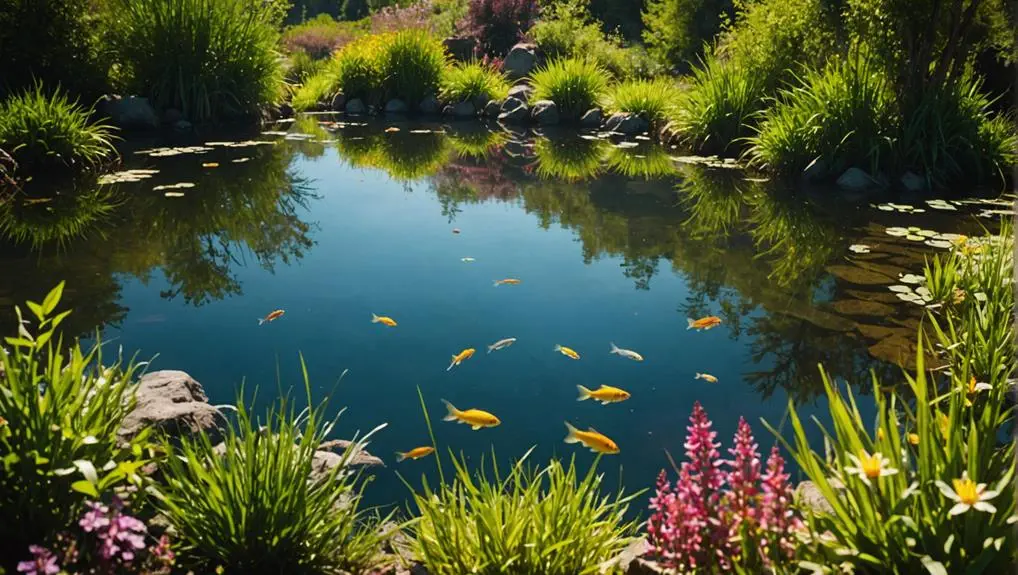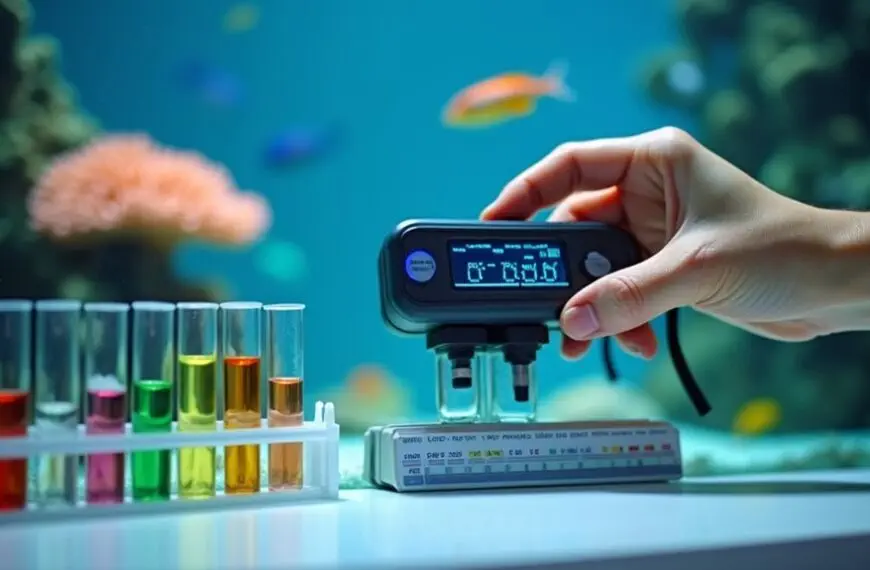You can easily enhance water quality for your fish using natural methods! Start by adding aquatic plants, like water lilies, which absorb excess nutrients while providing oxygen—pretty great multitaskers, right? Also, don't underestimate the power of beneficial bacteria—they act like tiny cleanup crews, breaking down waste and competing with pesky algae. Keep an eye on your water's pH and dissolved oxygen levels, aiming for about 6.5 to 8.5 and above 4 ppm, respectively. And remember, adding native plants can make your tank look snazzy while improving clarity. Keep swimming for more tips to create the perfect underwater haven!
Contents
Understanding Water Quality Factors
When it comes to maintaining a healthy aquatic environment, understanding water quality factors is crucial.
You've got to keep an eye on things like pH values, which should ideally be between 6.5 and 8.5 for happy fish. Extreme levels can be a fish's worst nightmare!
Monitoring dissolved oxygen levels is just as important; aim for over 4 ppm to keep your fish swimming strong.
Don't forget about nutrients and organic matter, too. The right balance prevents algae from throwing a party.
Beneficial bacteria play a key role here. They break down fish waste and other organic materials, helping to clear the water and keep it healthy.
You'll also want to watch out for suspended particles. If turbidity is high, it can cloud your pond, making it harder for aquatic plants to thrive.
Lastly, remember that biological filtration is your friend. It helps filter out unwanted substances, ensuring a stable environment for your fish.
Beneficial Bacteria for Water Clarity
Beneficial bacteria are essential allies in your quest for crystal-clear water in ponds and aquariums. These tiny organisms work tirelessly to break down organic waste, improving water clarity and creating a thriving environment for your fish. By converting harmful nitrites into less toxic nitrates, they help aquatic plants flourish, too!
Here are four key benefits of adding beneficial bacteria to your aquatic systems:
- Algal Bloom Control: They compete for nutrients with algae, reducing those pesky algal blooms that can cloud your water.
- Balanced Ecosystem: By maintaining a healthy balance in your pond or aquarium, they support not just fish but all aquatic life.
- Enhanced Water Quality: Regularly introducing these bacteria can significantly improve water clarity, especially when you use effective biofiltration systems.
- Nutrient Cycling: They promote nutrient cycling, ensuring that dissolved oxygen levels stay optimal for your fish and plants.
To keep these bacteria thriving, make sure the oxygen levels exceed 4 ppm.
With a little help from these microscopic champions, you'll enjoy a beautiful and healthy aquatic ecosystem!
Importance of Aquatic Plants

Aquatic plants are vital for maintaining a balanced ecosystem in your pond or aquarium. These green wonders play a key role in nutrient absorption, helping to prevent pesky algal blooms by soaking up excess nitrates and phosphates.
Imagine your fish happily swimming in clear water instead of a green soup!
Plus, species like water lilies and cattails provide essential habitats for fish and other wildlife, promoting biodiversity. You're not just creating a pretty pond; you're fostering a mini-ecosystem.
As these plants photosynthesize, they release dissolved oxygen, which is critical for fish health and survival. More oxygen means happier fish!
Diverse aquatic plants also improve water clarity by stabilizing sediments and offering a cozy home for beneficial bacteria that break down organic matter.
But don't forget about regular maintenance! Pruning and caring for your aquatic plants will keep them healthy and effective, filtering pollutants and ensuring they don't compete too much with fish populations.
Monitoring Water Parameters
Keeping an eye on water parameters is essential for a thriving fish environment. When you monitor these factors, you help create a healthy pond ecosystem that supports your finned friends.
Here are four key aspects to keep track of:
- pH Levels: Aim for a range between 6.5 and 8.5. This helps maintain water quality and keeps your fish happy.
- Dissolved Oxygen: Keep concentrations above 4 ppm. Fish need oxygen just like we need air; without it, they can become stressed.
- Temperature: Measure it at least twice a day. Different fish species have their own preferred thermal ranges, so adjust accordingly.
- Turbidity: Monitor turbidity levels, staying below 100 mg/l. High turbidity can hinder light penetration and affect photosynthesis, which is crucial for your pond's health.
Natural Filtration Methods

Natural filtration methods can significantly enhance water quality in your pond, creating a healthier environment for your fish. One effective way is to plant native aquatic vegetation. These plants, like cattails and water lilies, absorb excess nutrients and improve water clarity. Plus, they look lovely!
You can also utilize beneficial bacteria, which act like tiny cleanup crews, breaking down organic material and reducing harmful algae. This helps promote a thriving pond ecosystem.
Incorporating biofiltration systems can take it a step further. These systems combine physical and biological filtration to break down pollutants, making the water safer for your fish.
Have you ever considered adding floating islands or rafts with rooted plants? They create extra surface area for beneficial microbes to grow and work their magic through nutrient uptake.
Frequently Asked Questions
How Do I Improve My Aquarium Water Quality?
To improve your aquarium water quality, focus on filter maintenance, regular testing, and appropriate substrate choice. Implement consistent water changes, manage algae, and ensure fish compatibility while benefiting from plants and optimizing biofilter efficiency and temperature control.
How to Make Water Safe for Fish Without Chemicals?
Isn't it amazing how you can create a safe fish habitat naturally? Focus on natural filtration, beneficial bacteria, live plants, and regular maintenance. Don't forget water testing, temperature regulation, and consistent water changes for ecosystem balance!
How to Keep Water Healthy for Fish?
To keep water healthy for your fish, regularly test pH and temperature, maintain substrate, use filtration systems, encourage beneficial bacteria, incorporate aquatic plants, and ensure fish compatibility while employing aeration techniques for optimal conditions.
How to Purify Water for Fish?
To purify water for fish, you'll need to maintain pH balance, regulate temperature, and perform regular water changes. Add beneficial bacteria, activated charcoal, and natural decor for biological filtration, ensuring oxygen levels and algae control are optimal.
Final Thoughts
So, if you want your fish to live like royalty, take these natural water quality tips to heart! By adding beneficial bacteria, planting aquatic greenery, and keeping an eye on your water parameters, you're setting the stage for a thriving underwater paradise. It's like giving your fish a five-star resort experience—complete with room service! Remember, a little effort goes a long way in making your aquatic friends happy and healthy. Dive in, and let nature do its magic!












